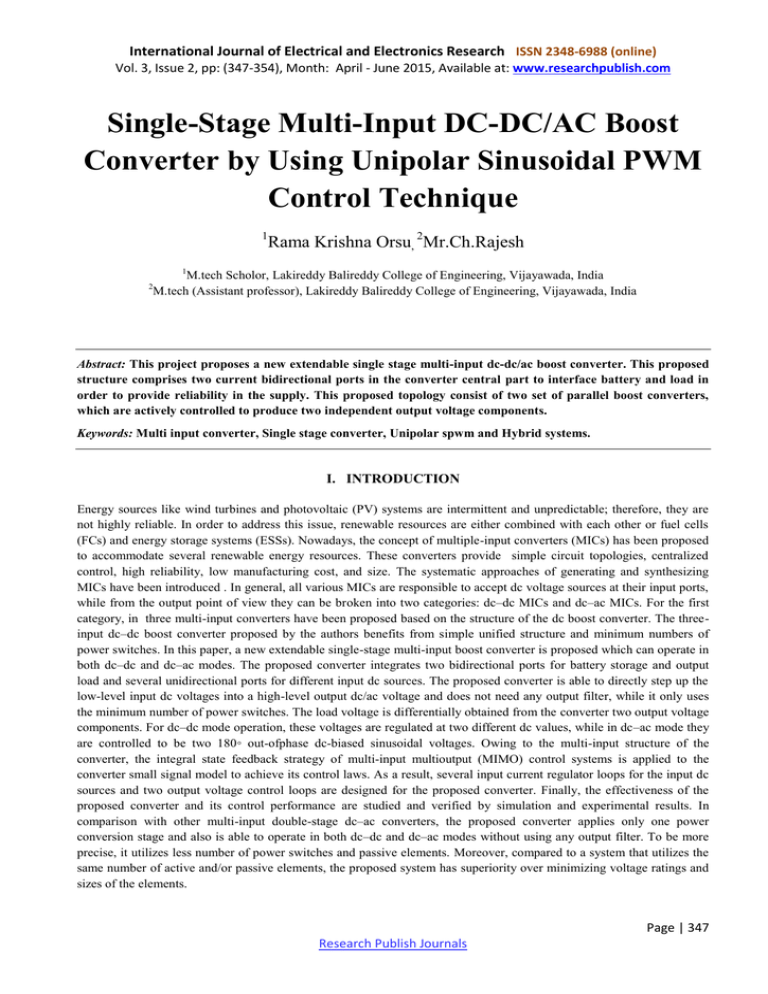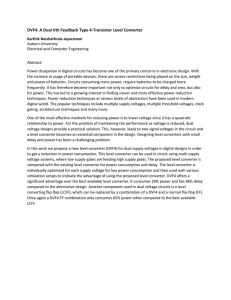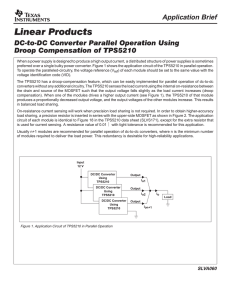Single-Stage Multi-Input DC-DC/AC Boost Converter by Using
advertisement

International Journal of Electrical and Electronics Research ISSN 2348-6988 (online) Vol. 3, Issue 2, pp: (347-354), Month: April - June 2015, Available at: www.researchpublish.com Single-Stage Multi-Input DC-DC/AC Boost Converter by Using Unipolar Sinusoidal PWM Control Technique 1 Rama Krishna Orsu, 2Mr.Ch.Rajesh 1 M.tech Scholor, Lakireddy Balireddy College of Engineering, Vijayawada, India M.tech (Assistant professor), Lakireddy Balireddy College of Engineering, Vijayawada, India 2 Abstract: This project proposes a new extendable single stage multi-input dc-dc/ac boost converter. This proposed structure comprises two current bidirectional ports in the converter central part to interface battery and load in order to provide reliability in the supply. This proposed topology consist of two set of parallel boost converters, which are actively controlled to produce two independent output voltage components. Keywords: Multi input converter, Single stage converter, Unipolar spwm and Hybrid systems. I. INTRODUCTION Energy sources like wind turbines and photovoltaic (PV) systems are intermittent and unpredictable; therefore, they are not highly reliable. In order to address this issue, renewable resources are either combined with each other or fuel cells (FCs) and energy storage systems (ESSs). Nowadays, the concept of multiple-input converters (MICs) has been proposed to accommodate several renewable energy resources. These converters provide simple circuit topologies, centralized control, high reliability, low manufacturing cost, and size. The systematic approaches of generating and synthesizing MICs have been introduced . In general, all various MICs are responsible to accept dc voltage sources at their input ports, while from the output point of view they can be broken into two categories: dc–dc MICs and dc–ac MICs. For the first category, in three multi-input converters have been proposed based on the structure of the dc boost converter. The threeinput dc–dc boost converter proposed by the authors benefits from simple unified structure and minimum numbers of power switches. In this paper, a new extendable single-stage multi-input boost converter is proposed which can operate in both dc–dc and dc–ac modes. The proposed converter integrates two bidirectional ports for battery storage and output load and several unidirectional ports for different input dc sources. The proposed converter is able to directly step up the low-level input dc voltages into a high-level output dc/ac voltage and does not need any output filter, while it only uses the minimum number of power switches. The load voltage is differentially obtained from the converter two output voltage components. For dc–dc mode operation, these voltages are regulated at two different dc values, while in dc–ac mode they are controlled to be two 180◦ out-ofphase dc-biased sinusoidal voltages. Owing to the multi-input structure of the converter, the integral state feedback strategy of multi-input multioutput (MIMO) control systems is applied to the converter small signal model to achieve its control laws. As a result, several input current regulator loops for the input dc sources and two output voltage control loops are designed for the proposed converter. Finally, the effectiveness of the proposed converter and its control performance are studied and verified by simulation and experimental results. In comparison with other multi-input double-stage dc–ac converters, the proposed converter applies only one power conversion stage and also is able to operate in both dc–dc and dc–ac modes without using any output filter. To be more precise, it utilizes less number of power switches and passive elements. Moreover, compared to a system that utilizes the same number of active and/or passive elements, the proposed system has superiority over minimizing voltage ratings and sizes of the elements. Page | 347 Research Publish Journals International Journal of Electrical and Electronics Research ISSN 2348-6988 (online) Vol. 3, Issue 2, pp: (347-354), Month: April - June 2015, Available at: www.researchpublish.com 1.1 BLOCK DIAGRAM REPRESENTATION OF PROPOSED CONVERTER (D.C / A.C) OUTPUT LOAD VO = (VO1-VO2) VO - + D.C SOURCE Vs(n-1) + - VO2 VO1 D.C- DC BOOST CONVERTER + - CURRENT BIDIRECTIONAL “H” BRIDGE CONVERTERS + - D.C-D.C BOOST CONVERTER + - D.C SOURCE Vsn BATTERY SUPPLY (VB) (Pulse amplification)/(Gate Driver circuit) Gate pulses Fig.1. Over view of proposed converter 2. PROPOSED CONVERTER AND OPERATION MODES The structure of the proposed extendable single-stage multi input dc–dc/ac boost converter is illustrated in Fig. 2. As indicated in the figure, in the converter central part, two bidirectional ports are provided to connect the output load and battery storage. The output load is connected between two dc-link voltages VO1 and VO2 , which are unipolar and independently obtained from the voltages across two common output capacitors of several parallel dc boost converters. Page | 348 Research Publish Journals International Journal of Electrical and Electronics Research ISSN 2348-6988 (online) Vol. 3, Issue 2, pp: (347-354), Month: April - June 2015, Available at: www.researchpublish.com The middle boost converters are current bidirectional and connected to the dc-link of the common battery, while the other ones (i.e., i = 3, . . . , n) are current unidirectional and fed from separate input dc sources (i.e., Vi3 , . . . , Vin ). The first aim of using the battery storage is to supply or absorb the power difference between the total generated dc power by the input dc sources and the load power. In this hybrid system, all kind of rechargeable batteries and also ultra capacitors are applicable as ESS. For the proposed system, the single power switch of each unidirectional boost converter is controlled to regulate the dc power of its corresponding input source, while in the converter central part both upper and lower power switches of the bidirectional boost converters are complementary switched to produce their corresponding output reference voltages. Thus, n different duty ratios ( d1 , . . . , and dn ) are introduced to control the converter power switches S1, S∗ 1, S2, S2*, S3 , . . . , and Sn, respectively. These duty ratios are the converter controlling variables that facilitate current and voltage regulation goals of the proposed system. For the proposed system, the input dc sources Vi3 , . . . , Vin should deliver n-2 ripple free dc currents, i.e., IL3 , . . . , ILn, respectively. Thus, the total generated dc powers at the both sides of the converter are expressed as follows: ∑ ( ) ( ) ∑ (1) The proposed converter can work in both dc–dc and dc–ac modes. Following sections will try to demonstrate operation principles of the proposed converter in these operation modes. 2.1 DC–DC MODE If two different dc values are chosen as the converter output reference voltages, then a pure dc voltage appears across the output load as follows: (2) For an output resistive load the consumed power can be expressed by the following equations: ( ( ) ( ) ) (3) Now, we obtain the converter first- and second-side powers Po1 and Po2 delivered to the load as follows ( ) ( ) ( ) ( ) (4) As seen in (4), first side of the converter delivers the positive power amount Po1 , while the negative power amount of Po2 is absorbed by the converter second side. These powers are constant values that only depend on the converter both side voltages. By neglecting converter power losses, the battery’s both sides powers are obtained as follows: ∑ ( ) ( ) ∑ (5) The summation of Pb1 and Pb2 gives the battery total exchanged power as follows: ∑ (6) As (6) shows, the battery source supplies or absorbs the power difference between the load power and the total generated input power. The battery current Ib and its both side inductor currents IL1 and IL2 are determined as follows: ∑( ) ( ) (7) Page | 349 Research Publish Journals International Journal of Electrical and Electronics Research ISSN 2348-6988 (online) Vol. 3, Issue 2, pp: (347-354), Month: April - June 2015, Available at: www.researchpublish.com 2.2 DC-AC MODE If the converter reference voltages are chosen as (8), then the proposed converter will operate in the dc–ac mode as ( ) ( ( )) ( ) ( ( )) (8) where their dc parts are the same as Vdc and the modulation of each sinusoidal part is ̇ out of phase with the other one. This concept results in generating a pure sinusoidal voltage across the load as follows: ( ) ( ) ( ) (9) Instantaneous current and power of an output resistive load can be expressed by the following equations: ( ) ( ) ( ( ) ( ) ( ) ( ) ) (10) In (10), the average quantity (Vm Im)/2 corresponds to the load average power ¯ Po , while the alternative term at the angular frequency of 2ω denotes the pulsation component of the load power. Now, the converter first- and second-sides instantaneous powers delivered to the load are obtained as follows: ( ) ( ) ( ( ( ) ( ) ( ) ) ( ( ) ) ( [ ( ) ) ] (11) As (11) shows, the average powers delivered to the load at the both sides of the converter are the same and equal to the half of the load average power for all power operation conditions. 2.3 UNIPOLAR SPWM In this scheme, the triangular carrier waveform is compared with two reference signals which are positive and negative signal. The basic idea to produce SPWM with Unipolar voltage switching is shown in Figure 4. The different between the Bipolar SPWM generators is that the generator uses another comparator to compare between the inverse reference waveform−Vr . The process of comparing these two signals to produce the Unipolar voltage switching signal is graphically illustrated in Figure 4. In Unipolar voltage switching the output voltage switches between 0 and dc V , or between 0 and dc −V . This is in contrast to the Bipolar switching strategy in which the output swings between dc V and Page | 350 Research Publish Journals International Journal of Electrical and Electronics Research ISSN 2348-6988 (online) Vol. 3, Issue 2, pp: (347-354), Month: April - June 2015, Available at: www.researchpublish.com dc −V . As a result, the change in output voltage at each switching event is halved in the Unipolar case from 2Vdc to Vdc. The effective switching frequency is seen by the load is doubled and the voltage pulse amplitude is halved. Due to this, the harmonic content of the output voltage waveform is reduced compared to Bipolar switching. In Unipolar voltage switching scheme also, the amplitude of the significant harmonics and its sidebands is much lower for all modulation indexes thus making filtering easier, and with its size being significantly smaller. Fig.4.Unipolar Sinusoidal Pulse Width Modulation Pulses 3. SIMULATION RESULTS In this section, the introduced converter in Fig. 2 is simulated by PSCAD/MATLAB software to show its operation performances in both dc–dc and dc–ac modes. In addition, a changeable resistive load is connected to the output port. In simulations, using the obtained input/output voltages in (and considering the voltage drops across passive and active elements, the voltages of input dc sources, battery storage, and the maximum and dc-bias values of the converter output voltage are set at following values: Vi3 = 80V, Vi4 = 95V, Vi5 = 90V, Vi6 = 85V VB = 96V, Vm = 280V Vdc=240V, S3=45%, S5=60% S4=45%, S6=40%, S1=20%, S1*=80%, S2=20%,S2*=80% and switching frequency(fs)=20khz SIMULATION PARAMETERS Resistors(ohms) Inductors(mH) Capacitors(uF) r1=0.1 L1=5 C1=1200 r2=0.1 L2=5 C2=1200 r3=0.15 L3=4 VB=96V r4=0.25 L4=5 Fs=20khz r5=0.1 L5=3.5 r6=0.2 L6=4.5 Page | 351 Research Publish Journals International Journal of Electrical and Electronics Research ISSN 2348-6988 (online) Vol. 3, Issue 2, pp: (347-354), Month: April - June 2015, Available at: www.researchpublish.com 3.1 SIMULATION RESULTS IN DC-DC MODE In this mode, the load voltage is desired to be VO = 230 V. And for this matter, the converter output voltages VO1 and VO2 are regulated at the reference dc voltages of VO1ref = 366 V and VO2ref = 136 V, respectively. The reference currents of the input dc sources are considered to be variable, which will result in providing three different periods of simulation. Fig. 5 depicts both output generated voltages alongside the load voltage, well produced at 366 V, 136 V, and 200 V, respectively. which are well regulated at their reference values with the current ripple less than 5%.denoting the delivering and absorbing two powers PO1 and PO2 at the both side of the converter. The theoretical average value of the battery current is Ib.ave = (Po–Pi1–Pi 2 )/Vb and due to supplying the converter power losses, it will be set at a value a little more than the theoretical value a power about PO = 3.3 kW (RL = 16 Ω) . Fig.5. Converter Output Voltage Waveform in dc-dc mode Fig.6. Battery and Inductor Currents in the dc-dc mode 3.2 SIMULATION RESULTS IN DC-AC MODE In this mode, the output voltage of the converter is desired to be a 60 Hz sinusoidal waveform with an rms-value equals to the Vrms = 100 V (Vm = 141.4 V). Thus, the parameters of the two output dc-biased sinusoidal voltages VO1 and VO2 are chosen to be Vm/2=70.7 V and Vdc = 285 V. With the intention of achieving similar results, the load power, the input dc sources Vi3 to Vi6 and their reference currents values are chosen to be as the same as those in the dc–dc mode. Therefore, three similar periods are provided for the system. Fig.7 and Figures.8(a) and (b) depict the both dc-biased sinusoidal voltages beside the load voltage and current, before and after applying the system step changes at the moment of 0.2 s and 0.4 s, respectively. As is clear the load voltage is perfectly generated sinusoidal (THD =0.69%) and does not experience any voltage quality problems, i.e., voltage sags/swells, coming from the fact that the battery is immediately charged/discharged to support input sources in online producing the desired output voltages. Page | 352 Research Publish Journals International Journal of Electrical and Electronics Research ISSN 2348-6988 (online) Vol. 3, Issue 2, pp: (347-354), Month: April - June 2015, Available at: www.researchpublish.com Fig.7. Converter Output Voltage Waveforms in dc-ac mode Fig.8. Battery current Waveform in dc-ac mode 4. CONCLUSION The single stage multi-input boost converter which can work in both dc-dc and dc-ac modes has been proposed in this paper it is extendable to accept more number of input dc sources and the proposed converter does not need any output filter. The proposed converter utilizes minimum number of power switches, current ripple<5% in dc-dc mode and Total harmonic distortion(T.H.D=0.69%) drastically reduced in dc-ac mode and so pure sinusoidal voltage wave form appeared across converter output with-out using any external filter arrangement. This is possible by the battery autonomously charging/discharging placed at the converter central part. REFERENCES [1] M. Sarhangzadeh, S. H. Hosseini, M. B. B. Sharifian, and G. B. Gharehpetian, “Multi-input direct DC-AC converter with high frequency link for clean power generation systems,” IEEE Trans. Power Electron., vol. 26, no. 6, pp. 625– 631, Jun. 2011. [2] Y. M. Chen, Y. C. Liu, S. C. Hung, and C. S. Cheng, “Multi-input inverter for grid-connected hybrid PV/Wind power system,” IEEE Trans. Power Electron., vol. 22, no. 3, pp. 1070–1077, May 2007. [3] L. Yan, R. Xinbo, Y. Dongsheng, L. Fuxin, and C. K. Tse, “Synthesis of multiple-input DC/DC converters,” IEEE Trans. Power Electron., vol. 25, no. 9, pp. 2372–2385, Sep. 2010. Page | 353 Research Publish Journals International Journal of Electrical and Electronics Research ISSN 2348-6988 (online) Vol. 3, Issue 2, pp: (347-354), Month: April - June 2015, Available at: www.researchpublish.com [4] Hhh A. Kwasinski, “Identification of feasible topologies for multiple-input DC–DC converters,” IEEE Trans. Power Electron., vol. 24, no. 3, pp. 856– 861, Mar. 2010. [5] L. Solero, A. Lidozzi, and J. A. Pomilio, “Design of multiple-input power converter for hybrid vehicles,” IEEE Trans. Power Electron., vol. 20, no. 5, pp. 1007–1016, Sep. 2005. [6] Kkk A. Khaligh, J. Cao, and Y. J. Lee, “A multiple-input DC–DC converter topology,” IEEE Trans. Power Electron., vol. 24, no. 3, pp. 862–868, Mar. 2009. [7] F. Nejabatkhah, S. Danyali, S. H. Hosseini, M. Sabahi, and S. A. KH. Mozafari Niapour, “Modeling and control of a new three-input DC–DC boost converter for hybrid PV/FC/battery power system,” IEEE Trans. Power Electron., vol. 27, no. 5, pp. 2309–2324, May 2012. [8] H. Tao, A. Kotsopoulos, J. L. Duarte, and M. A. M. Hendrix, “Family of multiport bidirectional DC–DC converters,” in Proc. IEE Elect. Power Appl., Apr. 2006, pp. 451–458. [9] Zh. Qian, O. A. Rahman, H. A. Atrash, and I. Batarseh, “Modeling and control of three-port DC/DC converter interface for satellite applications,” IEEE Trans. Power Electron., vol. 25, no. 3, pp. 637–649, Mar. 2010. [10] Zh.Qian,O. A. Rahman, and I. Batarseh, “An integrated four-port DC/DC converter for renewable energy applications,” IEEE Trans. Power Electron., vol. 25, no. 7, pp. 1877–1887, Jul. 2010. Author’s Profile: Rama Krishna Orsu was born in Guntur, Andhra Pradesh in 1990 and he attained his B.Tech degree in Electrical and Electronics engineering from Vignan’s Lara Institute of Technology And Science, Vadlamudi in the year 2012 and he pursuing M.Tech in Power Electronics And Drives from Lakkireddy Balireddy College Of Engineering, Mylavaram. His area of interest includes Power Electronics, Control Systems and Electrical machines. Rajesh Chintalapudi pursued B.Tech from DVR&DR.HS MIC College Of Technology in Electrical And Electronics Engineering , Kanchancharla in the year 2009, M.Tech in Power Electronics And Drives from NIT CALICUT,Calicut in the year 2012.He was doing Assistant professor in Gudlavalleru Engineering College from 2013 to 2014, Currently he has been working in Lakireddy Balireddy College Of Engineering since 2014.His area of interest includes Solar Power Inverters,and also he published several national and international journals On reactive power compensattion in a grid connected photo voltaic systems and Multilevel converters. Page | 354 Research Publish Journals



